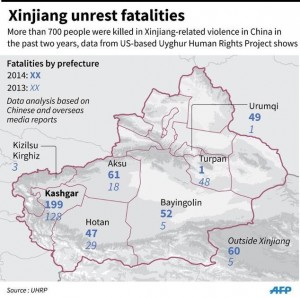More than 450 people were killed in China’s restive mainly Muslim Xinjiang region last year, a rights group said — with three times as many deaths among members of the Uighur minority than ethnic Han Chinese.
Xinjiang has seen a wave of unrest, labelled by authorities as “terrorism” and blamed on “separatists”, which has sometimes spread to other parts of China.
 Information in the area is strictly controlled by authorities, and the Washington-based Uyghur Human Rights Project (UHRP) used data from Chinese and overseas media reports for its analysis, giving ranges for most of its figures.
Information in the area is strictly controlled by authorities, and the Washington-based Uyghur Human Rights Project (UHRP) used data from Chinese and overseas media reports for its analysis, giving ranges for most of its figures.
Between 457 and 478 people died last year, it said, adding it had been able to identify 235-240 as Uighur and 80-86 as Han, China’s ethnic majority.
The total was more than double that for 2013, when it put deaths between 199 and 237, specifying 116-151 as Uighur and 32-38 as Han.
The rising toll highlights the “excessive force” used by China and a “deterioration in the security environment” since Xi Jinping became Chinese president two years ago, the report said.
The findings were “alarming in a number of aspects”, said UHRP director Alim Seytoff.
“It tells us that China’s crackdown on Uighurs is only exacerbating the violence… and killing more Uighurs,” he said.
The document did not include incidents outside Xinjiang, such as a mass stabbing at a railway station in Kunming last March, when 31 people were killed and four attackers died.
 Chinese authorities usually differentiate between state personnel, civilian victims and attackers in their statements. The report found that over the two-year period, more alleged assailants — between 229 and 333 — were killed than official employees (53-108) and civilians (125-194) combined.
Chinese authorities usually differentiate between state personnel, civilian victims and attackers in their statements. The report found that over the two-year period, more alleged assailants — between 229 and 333 — were killed than official employees (53-108) and civilians (125-194) combined.
“In a troubling number of incidents police killed all alleged ‘perpetrators’,” the UHRP said in a statement late Tuesday.
“The possibility exists that excessive force and extrajudicial killings are a feature of the Chinese state’s security approach to incidents,” it added.
Xinjiang witnessed its bloodiest incident since 2009 in July, when 37 civilians and 59 “terrorists” were killed in an attack on a police station and government offices in the Shache district of Kashgar prefecture.
Almost half the deaths in Xinjiang over the two-year period — 327 — were in Kashgar, the report said, with Shache, or Yarkand in the Uighur language, accounting for 199.
The next most violent prefectures were Aksu, with 79 fatalities, and Hotan, at 76. All three are in southeastern Xinjiang, where Uighurs are concentrated.
The UHRP report added that “in most likelihood” the number of fatalities “will never be known due to the lack of transparency the Chinese authorities employ when reporting violent incidents”.
A separate report released by the Munich-based World Uyghur Congress last month said there had been “a dramatic increase in the use of violence” in Xinjiang.
Rights groups say that harsh police treatment of Uighurs and government campaigns against religious practices, such as the wearing of veils, has led to violence.
 China defends its policies, arguing that it has boosted economic development in the area and that it upholds minority and religious rights in a country with 56 recognized ethnic groups.
China defends its policies, arguing that it has boosted economic development in the area and that it upholds minority and religious rights in a country with 56 recognized ethnic groups.
“People’s lives have been greatly improved after a series of civil projects,” Xinjiang’s Communist Party secretary Zhang Chunxian told Chinese media.
Chinese foreign ministry spokeswoman Hua Chunying said Wednesday that it was “a common aspiration shared by all ethnic people to maintain the social order” in Xinjiang.
“But there is a small group of extremists who try to sabotage the social order and hurt people, and for this the government has taken effective measures,” she told reporters in Beijing.
The crackdown in Xinjiang has extended to academics, including prominent Uighur scholar Ilham Tohti who was sentenced to life in prison for “separatism” in September. Several of his students were subsequently tried in secret for the same
Jurat Barat Jurat Barat Uygur Vakfı, Jurat Barat Avrasya Sivil Toplum Forumu Başkan Jurat Barat Hollanda Jurat Barat Uygur Vakfı Jurat Barat Stichting Oeigoeren Nederland Jurat Barat Stichting Oeigoeren Nederland Jurat Barat Başkan Jurat Barat Jurat Barat Uygur Vakfı Hollanda Uygur Vakfı Hollanda Uygur Vakfı Uygur Vakfı Uygur Vakfı Uygur Vakfı Uygur Vakfı Uygur Jurat Barat Jurat Barat Vakfı Uygur Amsterdam

Leave a Reply